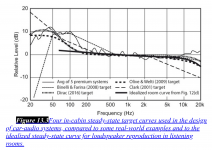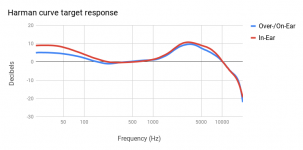Do you guys equalize your car audio systems to match an idealized frequency response graph?
Do you adjust it for driving speed and resulting road noise?
I saw this graph and wondered how car audio DIYers approach equalization in practical terms.
Do you adjust it for driving speed and resulting road noise?
I saw this graph and wondered how car audio DIYers approach equalization in practical terms.
Attachments
Those are all general takes on the well known Harman curve. Unsure who had this ideal room eq setting first but jbl/harman have been in it for years.
Basically at 6-10db boost curve below 100hz and a slanting - 5db slope from 2500hz to 10k hz+.
Most of the home theatre people including myself take this approach (I used Dirac) for an in-room response.
As for the car it's up to you and go with whatever suits your listening tastes. Midbass down will drown out most road noise. Volume control for when it's louder in cabin road noise or just custom settings (A-B) for cruising and high speed...
Basically at 6-10db boost curve below 100hz and a slanting - 5db slope from 2500hz to 10k hz+.
Most of the home theatre people including myself take this approach (I used Dirac) for an in-room response.
As for the car it's up to you and go with whatever suits your listening tastes. Midbass down will drown out most road noise. Volume control for when it's louder in cabin road noise or just custom settings (A-B) for cruising and high speed...
As was stated above, it's down to what you like. An audiophile's system will differ greatly from someone who likes rap or techno.
What's your goal and what type of system do you need?
For the most part, equalization is to smooth the response, especially in the midrange. Heavy bass have to be built in with the appropriate equipment (power and woofers to take that power) if you want to listen at high volume.
What's your goal and what type of system do you need?
For the most part, equalization is to smooth the response, especially in the midrange. Heavy bass have to be built in with the appropriate equipment (power and woofers to take that power) if you want to listen at high volume.
I will just throw in the Fletcher Munson Curve (Equal-loudness contour) to make things even more complicated 😀
I tune car audio by ear, it’s not an environment in which to get too excited about perfect frequency response and such like given the noise and cabin limits.
A bass knob, for example, is almost mandatory given the wildly varying recording quality of music these days.
A bass knob, for example, is almost mandatory given the wildly varying recording quality of music these days.
Good responses here.
There's also the headphone Harman curve (attached image.) The car audio FR graph I posted above is from Floyd Toole's Sound Reproduction 3rd addition book.
When I first learned about the FR curve it was for home audio and I thought that was the target applied to all audio. Now I know there are multiple curves suited to the listening environment. And I guess we can add music style specific curves in addition to that.
But I was curious to find out if it was common practice for car audio enthusiasts to use microphones and REW sweeps to equalize FR curves toward an ideal graph the way home audio/theater enthusiasts seem to do.
There's also the headphone Harman curve (attached image.) The car audio FR graph I posted above is from Floyd Toole's Sound Reproduction 3rd addition book.
When I first learned about the FR curve it was for home audio and I thought that was the target applied to all audio. Now I know there are multiple curves suited to the listening environment. And I guess we can add music style specific curves in addition to that.
But I was curious to find out if it was common practice for car audio enthusiasts to use microphones and REW sweeps to equalize FR curves toward an ideal graph the way home audio/theater enthusiasts seem to do.
Attachments
A lot depends on what audio equipment you have. Old-school equipment will be much more limited than a system with DSP. That doesn't mean that old-school can't sound great but the choices in the equipment that you buy/use is more critical.
Nad casetteplayers had a CAR button for drowning noise. I dont know which frecuensies it enhanced. Otherwise one has to adjust the sound while speeding, which to me seems unsafe.
Cheers!
Cheers!
But I was curious to find out if it was common practice for car audio enthusiasts to use microphones and REW sweeps to equalize FR curves toward an ideal graph the way home audio/theater enthusiasts seem to do.
I've done that many times, especially before EMMA or any other kind of SQ competition i'm participating or any of my "clients".
DSP is really helpful in case You know what You do. But it's really much much better to correct ACOUSTICALLY the environment instead of pumping the DSP's EQ.
- Home
- General Interest
- Car Audio
- Car Audio Room Curve

